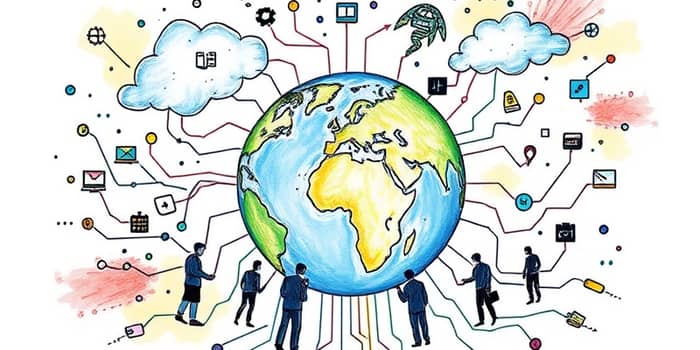
The world of risk is undergoing a fundamental transformation. As we enter 2025, organizations encounter a landscape defined by unprecedented speed, interconnection, and complexity. No longer bound by traditional silos, threats can cascade across industries and continents in moments, leaving leaders scrambling. One survey highlights that 82% of banking respondents were caught off guard by the swift escalation of risk during the 2023 regional banking crisis.
Yet within this volatility lie untapped opportunities. By embracing advanced analytics, fostering agile cultures, and reimagining risk as a strategic asset, enterprises can not only protect their operations but also drive innovation and sustainable growth.
In today’s environment, no threat exists in isolation. From supply chain disruptions to cyber attacks and climate-driven events, risks interlock and compound in ways that defy linear analysis. The collapse of Baltimore’s Key Bridge in 2024 exemplifies this reality: a minor structural failure triggered a web of economic and logistical shocks across the region.
Despite these dangers, only 37% of ERM leaders believe their risk maps capture all critical drivers, revealing a persistent gap in understanding. Effective risk management now demands a shift from static, siloed assessments toward dynamic models that reveal hidden dependencies and potential chain reactions.
Several risk categories dominate executive agendas for the coming years. While the specifics vary by sector, four priorities consistently emerge:
Together, these risks shape an environment where agility and anticipatory planning are table stakes rather than competitive differentiators.
Artificial intelligence stands at the vanguard of risk innovation. By 2025, forecasts indicate that 70% of risk managers will center AI within their frameworks, driven by a 35% annual growth rate in AI adoption. No longer confined to retrospective analysis, AI now empowers teams to forecast potential disruptions, flag anomalies in real time, and optimize resource allocation.
However, AI’s benefits come with their own hazards. Decision biases can be amplified if models are poorly calibrated, while sophisticated adversarial attacks can exploit machine learning vulnerabilities. Balancing automation and human expertise remains a critical challenge: organizations must implement robust governance structures to ensure that AI tools enhance rather than undermine resilience.
Risk and opportunity are two sides of the same coin. Firms that master advanced analytics and cultivate specialized talent can turn threats into strategic advantages. Key avenues include:
With specialized roles in cybersecurity, ESG analysis, and risk analytics in high demand, firms are racing to attract the talent needed to navigate this complex terrain.
Real-world examples illustrate how interconnected risks can either derail organizations or catalyze transformation:
During the 2023 regional banking crisis, a blend of social-media-driven bank runs and digital liquidity crunches caught many institutions unprepared. Yet those with advanced monitoring systems swiftly reallocated capital, imposed targeted controls, and preserved depositor confidence.
Similarly, the 2024 collapse of Baltimore’s Key Bridge exposed vulnerabilities in infrastructure risk assessments. Companies with robust interdependency mapping were able to reroute shipments, secure alternative logistics, and even provide local support, strengthening community relations.
Creating a resilient enterprise requires more than technology—it demands a fundamental cultural shift. Leaders must embed risk consciousness into every decision-making process, ensuring that evaluation of potential threats and opportunities is standard practice rather than an afterthought.
Developing a pipeline of specialized risk talent is equally vital. Emerging roles include:
By aligning incentive structures with risk outcomes, organizations can ensure that teams remain focused on both protecting assets and capitalizing on evolving market dynamics.
Regulatory demands continue to intensify. From data privacy and anti-money laundering to ESG disclosures and digital asset oversight, firms face a labyrinth of compliance requirements. Integrated Governance, Risk, and Compliance (GRC) platforms are emerging as indispensable tools for unified monitoring and rapid response.
Meanwhile, geopolitical uncertainty—from trade disputes to regional conflicts—adds another layer of complexity. Organizations must incorporate scenario analysis, geopolitical intelligence, and robust contingency planning to navigate sudden sanctions, policy shifts, or supply chain disruptions.
The next frontier of risk management is defined by three interlocking pillars. First, proactivity: organizations will shift from a defense posture to one where threats are anticipated and opportunities actively pursued. Second, digital transformation: seamless integration of AI, analytics, and automation will underpin advanced risk frameworks. Third, human judgment: despite technological gains, expert oversight and ethical considerations will remain indispensable.
Leaders who invest strategically in technology, culture, and talent will thrive in the face of new threats. By viewing risk not as a burden but as a catalyst for innovation, they will pioneer resilient business models that adapt, transform, and seize the myriad opportunities emerging in an ever-evolving landscape.
References













